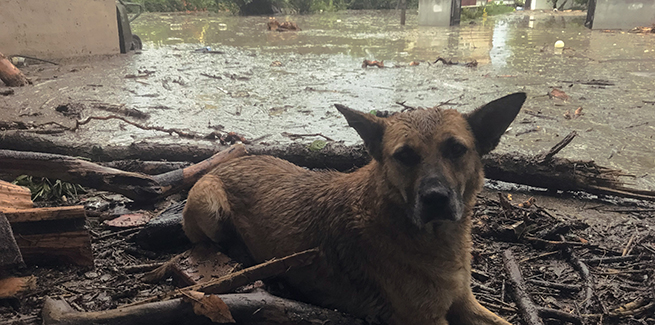Make sure clients have a pet evacuation plan in place

Wildfires in California and the Pacific Northwest, hurricanes in the Gulf Coast and up the Eastern seaboard, tornadoes in the Midwest, flooding in Texas: There’s hardly an area of the US that’s safe from some kind of natural disaster. And that includes both people and pets.
In fact, a recent survey from the American Society for the Prevention of Cruelty to Animals (ASPCA) showed 83% of pet owners live in an area impacted by disasters. And while more than 90%of pet owners said they would bring their pet with them during an evacuation, only 46% have a disaster preparedness plan in place.
September is National Preparedness Month, and the theme for 2021 is “Prepare to Protect. Preparing for disasters is protecting everyone you love.” For veterinarians, that means helping their clients be prepared to save their pets by encouraging them to have an evacuation plan in place.
Veterinary first responder Mary Whitlock, DVM, a 13-year member of the Oregon Veterinary Emergency Response Team (OVERT) and an organizing committee member for the Lane County Animals in Disaster Team/County Animal Response, told NEWStat she always made sure clients had copies of the American Veterinary Medical Association (AVMA)’s disaster preparedness pamphlet Saving the Whole Family. “[There’s] lots of good info there.”
She also gave them a link to the Texas A&M animal response (TAMU) website—“Another great website for information,” she said. “TAMU has such a great veterinary emergency response program—their team took over from our Oregon OVERT team when we went to help California with the Camp Fire animal response in 2018.”
Ever since Hurricane Katrina in 2005 brought home to her the tragedy of people leaving beloved pets behind during disaster evacuation, Whitlock has devoted herself to spreading the word about animal disaster response and preparedness and what veterinarians can to do help. But lately her focus has narrowed from the national to the local: “Right now I’m thinking that the need to prepare as a family, as a neighborhood, and as a community for the events that may occur in their region is the most important thing,” she said. “This is what will save human, companion animal, and livestock lives.”
Whitlock believes that veterinarians helping their communities prepare for disaster response is an excellent opportunity for the profession to shine: “Members of local veterinary associations can work together in helping a community become aware of the need on both the human and animal side.”
There’s an added benefit, Whitlock says: “[disaster preparedness] is an area of expertise our profession can share with our clients and community and we don’t have to worry about competing with the groomer, the dog breeder, the feed store, Dr. Google, or anyplace else our clients can obtain information.” Whatever the nature of the disaster, Whitlock says that helping our communities be prepared, “and being the experts at doing so” is a role the profession should embrace.
Whitlock hopes the news of the AVMA’s new veterinary first responder certification will help serve as a call to arms: “I'm hoping that this certification will wake up our profession to the need for animal disaster preparedness.” Even though the disasters are going to be very different regionally, Whitlock says, “they’re going to be similar in how we respond.”
Of people who’ve had to leave a pet behind, nearly 30% cited the main reason as not having enough time when the disaster struck. That’s where having a plan pays off.
According to the ASPCA, creating a portable pet emergency kit with essential items such as medical records, pet food, water, bowls, and the pet’s medication is a great first step in preparing for a potential evacuation.
“The more information we can have ready to go before the disaster, the better prepared we are,” Whitlock adds. “No matter what type of disaster it is.”
Photo credit © madcezir/iStock/Getty Images Plus via Getty Images



